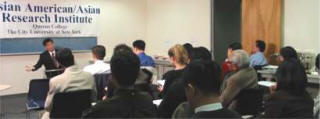
Based on a book currently being written for Columbia University on ethnic attachment, this talk will explain the solidarity among Chinese, Indian and Korean immigrants in New York City.
Sociologists often lump together ethnic attachment and ethnic solidarity into the same category. Though distinctively interrelated, both are significantly different from one another in their explanations of social phenomena and ethnic issues.
Ethnic attachment indicates the level of integration into an ethnic community; culturally, socially and psychologically, based on private identity. When one is more ethnic, they’ll tend to practice more of their ethnic customs, speak their native language, and meet more members of the same group.
Ethnic solidarity refers to the degree and use of ethnic collective action, such as political activities, protest demonstrations, and boycotts.
All three immigrant groups ranked high in ethnic attachment, but Koreans ranked the highest in terms of ethnic solidarity. Three major variables contribute to the differentiation of ethnic solidarity; group homogeneity, religious practice and economic action.
Group Homogeneity – Koreans have a better sense of group homogeneity than Indians and Chinese, due to the fact that almost all Korean immigrants came to the United States from South Korea, which is smaller than the state of Georgia, in 1965. Indians and Chinese on the other hand represent bigger countries, and most immigrants come from places outside their native countries.
Religious Practice – There are roughly six hundred Korean churches, compared to fifty Indian religious congregations in the New York metro area, since many Indians practice their religions at home. Chinese are the least religious, with a hundred churches and fifty Buddhist temples.
This is an important implication in terms of solidarity amongst Koreans, since church can be the mass basis for collective activities.
Economic Action – A majority of Koreans are self-employed, and are highly concentrated in several lines of businesses, especially in black neighborhoods. Conflict often develops between their customers, white suppliers and Latino employees, leading to the use of collective activities to protect their interests and help solidify their business associations.
Chinese however exhibit low self-employment, and hire mostly Chinese workers, which results in increased inter-group conflicts, leading to picketing outside of restaurants. Unlike the Chinese, Indians don’t have much inter-group conflicts, since a large portion of them are in medical professions, and the need for collective activities is entirely unnecessary, except for taxi drivers.
From these three factors, we can see why Koreans often use ethnic collective action.
In the New York City metro area, Chinese outnumber Koreans more than three times, and Indians 2.5 times. Koreans have a huge disadvantage in population and language barriers, unlike Indians and Chinese, who speak English better than Koreans. Currently in the New York area, there are four Indian school board members, with seven of them Chinese, and eight of them Korean. Koreans are highly segregated, and many believe that assimilation is crucial for their political development. Though they are the least assimilated, Koreans are still politically active, due to group homogeneity, church affiliations and business patterns that help contribute to political development.
The data on the following tables has been limited to Queens, home to 50% of the Asian American population in New York City; 72% Korean, 62% Indian and 43% Chinese. Though Queens is an excellent place for comparison, it is not does not provide an accurate depiction of all the Chinese in New York.
Socioeconomic levels can be used as a comparison to homogeneity. The Chinese community is polarized, with professionals on one end, and immigrants from Mainland China on the other. Most low class Chinese immigrants tend to support the Democratic Party. Immigration amongst Koreans has dropped since 1988, with South Korea doing much better economically, and with its more democratic government. Within the Chinese community, illegal immigrants are often exploited by their Chinese employers, leading to inter-group conflict.
A popular technique is the random sampling of twenty prominent surnames from each group from the phonebook, which updates its listing every year and is the most reliable source when doing research on immigrants.
Table 3 is based on data from the 1990 Census. New York City has a high number of self-employment in small businesses. The data from the 1990 Census underestimates the actual number of individuals who are self-employed, with 20% of Indian and Chinese, and 55% of Korean families owning at least one business. More small businesses result in a higher degree of ethnic attachment. Though higher degrees of ethnic attachment lead to segregation, it also in stronger collective action.
Synopsis by Antony Wong



Online Notes

